1998 PONTIAC BONNEVILLE Fuel door
[x] Cancel search: Fuel doorPage 6 of 395
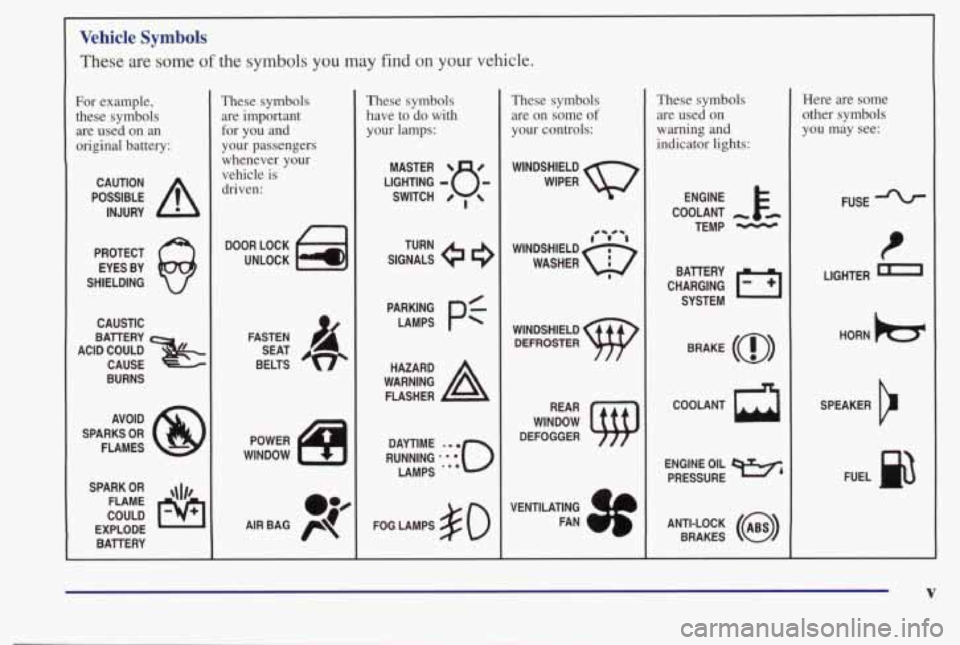
Vehicle Symbols
These are some of the symbols you may find on your vehicle.
For example,
these symbols are used on an
original battery:
POSSIBLE A
CAUTION
INJURY
PROTECT EYES BY
SHIELDING
Q
CAUSTIC
ACID COULD BAllERY
CAUSE -~~-. .
BURNS
AVOID
SPARKS
OR
FLAMES
SPARK
OR ,\I/,
COULD FLAME
EXPLODE BAllERY
I
These symbols are important
for you and
your passengers
whenever your
vehicle is
driven:
DOOR LOCK
UNLOCK
n
POWER
WINDOW
oJ4
AIR BAG p
These symbols
have to do with your lamps:
SIGNALS e3
TURN
FOG LAMPS
# 0
These symbols are on some
of
your controls:
WINDSHIELD
WIPER
WINDSHIELD
DEFROSTER
DEFOGGER
VENTILATING FAN
( rc?: A
These symbols are used on
warning
and
indicator lights:
COOLANT -
TEMP -
CHARGING I-1
BAllERY
SYSTEM
BRAKE
(a)
R
Here are some
other symbols
you may see:
FUSE
LIGHTER
n
HORN )b.
ENGINE OIL e,
PRESSURE
V
SPEAKER
b
FUEL
Page 68 of 395
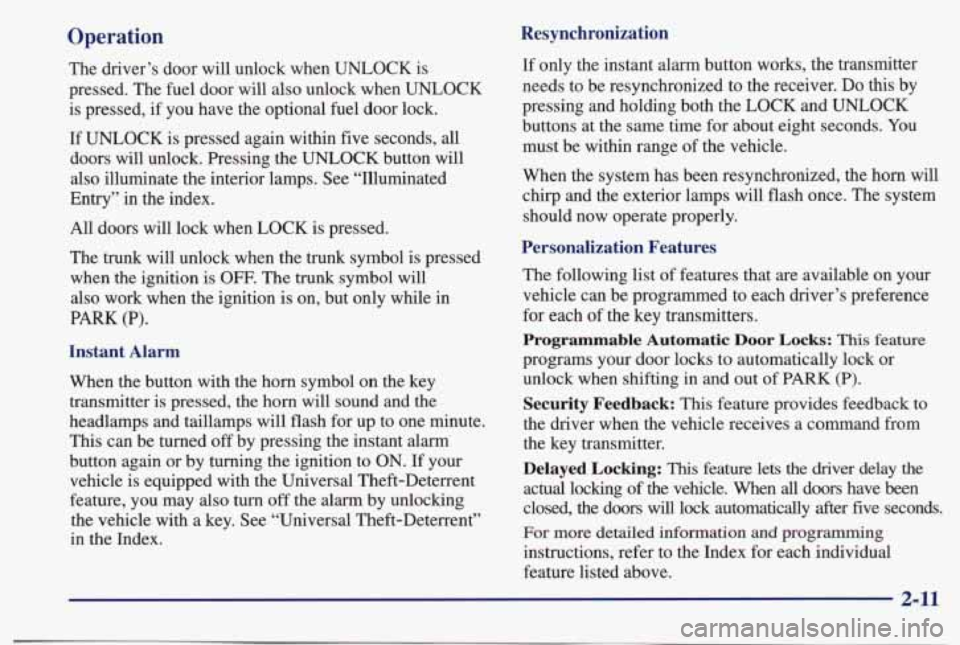
Operation
The driver’s door will unlock when UNLOCK is
pressed. The fuel door
will also unlock when UNLOCK
is pressed, if you have the optional fuel door lock.
If
UNLOCK is pressed again within five seconds, all
doors
will unlock. Pressing the UNLOCK button will
also illuminate the interior lamps. See “Illuminated
Entry”
in the index.
All doors will lock when LOCK is pressed.
The
trunk will unlock when the trunk symbol is pressed
when
the ignition is OFF. The trunk symbol will
also work when the ignition is on, but only while
in
PARK (P).
Instant Alarm
When the button with the horn symbol on the key
transmitter is pressed, the horn will sound and the
headlamps and taillamps will flash for up to one minute.
This can be turned off by pressing the instant alarm
button again or by turning the ignition to
ON. If your
vehicle is equipped with the Universal Theft-Deterrent
feature, you may also turn
off the alarm by unlocking
the vehicle with a key. See “Universal Theft-Deterrent”
in the Index.
Resynchronization
If only the instant alarm button works, the rransmitter
needs to be resynchronized to the receiver.
Do this by
pressing and holding both the
LOCK and UNLOCK
buttons at the same time for about eight seconds. You
must be within range of the vehicle.
When the system has been resynchronized, the horn
will
chrp and the exterior lamps will flash once. The system
should now operate properly.
Personalization Features
The following list of features that are available on your
vehicle can be programmed to each driver’s preference
for
each of the key transmitters.
Programmable Automatic Door Locks: This feature
programs your door locks to automatically lock or
unlock when shifting in and out
of PARK (P).
Security Feedback: This feature provides feedback to
the driver when the vehicle receives a command from
the key transmitter.
Delayed Locking: This feature lets the driver delay the
actual locking of the vehicle. When all doors have been
closed, the doors will lock automatically after five seconds.
For more detailed information
and programming
instructions, refer to the Index for each individual
feature listed above.
2-11
Page 135 of 395
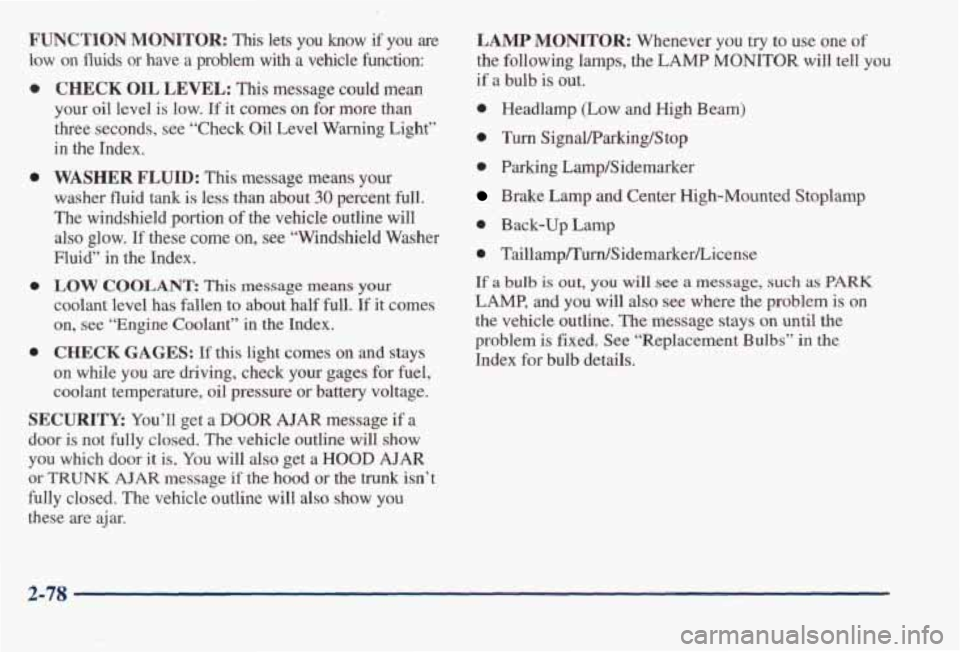
FUNCTION MONITOR: This lets you know if you are
low on fluids or have a problem with a vehicle function:
0
0
0
0
CHECK OIL LEVEL: This message could mean
your oil level
is low. If it comes on for more than
three seconds, see “Check Oil
Level Warning Light”
in the Index.
WASHER FLUID: This message means your
washer fluid
tank is less than about 30 percent full.
The windshield portion
of the vehicle outline will
also glow,
If these come on, see “Windshield Washer
Fluid” in the Index.
LOW COOLANT: This message means your
coolant level has fallen to about half full. If it comes
on,
see “Engine Coolant” in the Index.
CHECK GAGES: If this light comes on and stays
on while you are driving, check your gages for fuel,
coolant temperature, oil pressure or battery voltage.
SECURITY: You’ll get a DOOR AJAR message if a
door is not fully closed. The vehicle outline will show
you which door
it is. You will also get a HOOD AJAR
or TRUNK AJAR message if the hood or the trunk isn’t
fully closed. The vehicle outline will
also show you
these are ajar.
LAMP MONITOR: Whenever you try to use one of
the following lamps, the LAMP MONITOR will tell you
if a bulb is out.
0 Headlamp (Low and High Beam)
0 Turn Signal/Parking/Stop
0 Parking Lamp/Sidemarker
Brake Lamp and Center High-Mounted Stoplamp
0 Back-up Lamp
0 Taillamp~rn/Sidemarker/License
If a bulb is out, you will see a message, such as PARK
LAMP, and you will also see where the problem is on
the vehicle outline.
The message stays on until the
problem
is fixed. See “Replacement Bulbs” in the
Index for bulb details.
2-78
Page 202 of 395
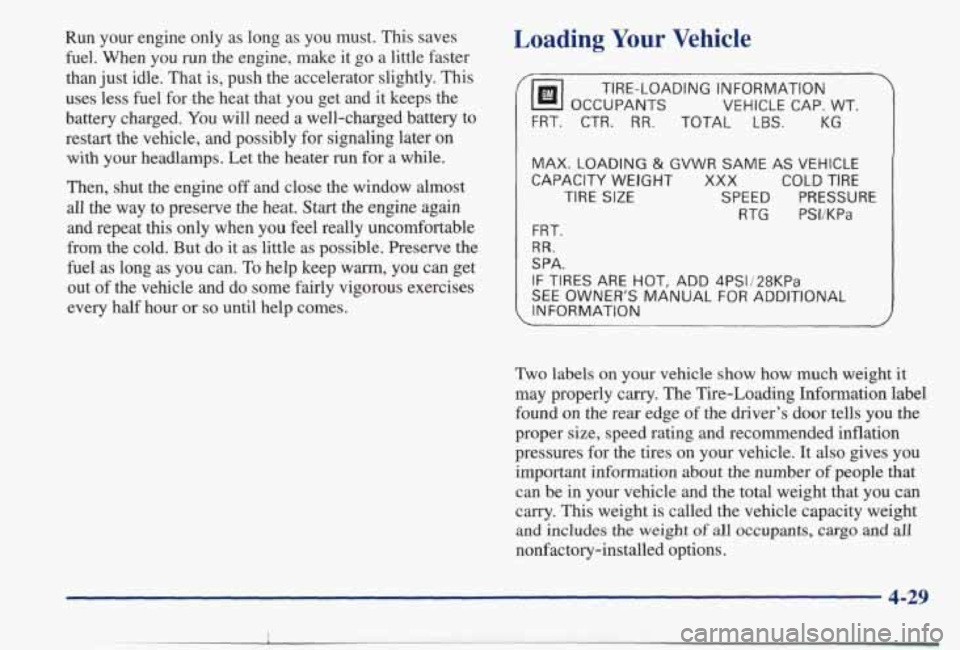
Run your engine only as long as you must. This saves fuel. When you run the engine, make it go a little faster
than just idle. That is, push the accelerator slightly. This
uses less fuel for .the heat that you get and it keeps the
battery charged. You will need
a well-charged battery to
restart the vehicle, and possibly for signaling later on
with your headlamps. Let the heater run for a while.
Then, shut the engine
off and close the window almost
all the way to preserve the heat. Start the engine again and repeat this only when you feel really uncomfortable
from the cold. But do
it as little as possible. Preserve the
fuel as long as you can. To help keep warm, you can get
out
of the vehicle and do some fairly vigorous exercises
every half hour
or so until help comes.
Loading Your Vehicle
;"
7
TIRE-LOADING INFORMATION
OCCUPANTS
VEHICLE CAP. WT.
FRT. CTR.
RR. TOTAL LBS. KG
MAX. LOADING & GVWR SAME AS VEHICLE
CAPACITY WEIGHT
XXX COLD TIRE
TIRE SIZE SPEED PRESSURE
RTG PSVKPa
FRT.
RR.
SPA.
IF TIRES ARE HOT, ADD 4PS1/28KPa
SEE OWNER'S MANUAL FOR ADDITIONAL
, INFORMATION
Two labels on your vehicle show how much weight it
may properly carry. The Tire-Loading Information label
found on
the rear edge of the driver's door tells you the
proper size, speed rating and recommended inflation
pressures for the tires on your vehicle. It also gives you
important information about the number
of people that
can be in your vehicle and the total weight that you can
carry. This weight is called the vehicle capacity weight
and includes the weight of all occupants, cargo and all
nonfactory-installed options.
4-29
Page 203 of 395
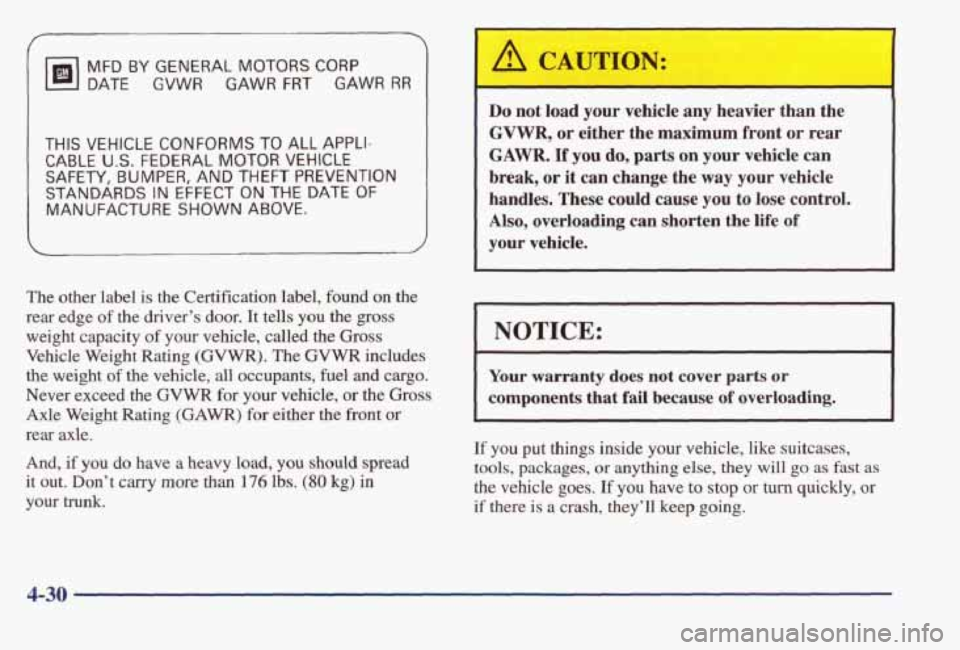
MFD BY GENERAL MOTORS CORP
DATE GVWR GAWR FRT GAWR RR
THIS VEHICLE CONFORMS TO ALL APPLI-
CABLE U.S. FEDERAL MOTOR VEHICLE
SAFETY, BUMPER, AND THEFT PREVENTION
STANDARDS IN EFFECT ON THE DATE OF
MANUFACTURE SHOWN ABOVE.
The other label is the Certification label, found on the
rear edge
of the driver’s door. It tells you the gross
weight capacity of your vehicle, called the Gross
Vehicle Weight Rating
(GVWR). The GVWR includes
the weight of the vehicle, all occupants, fuel and cargo.
Never exceed the GVWR for
your vehicle, or the Gross
Axle Weight Rating
(GAWR) for either the front or
rear axle.
And, if you do have a heavy load, you should spread
it
out. Don’t carry more than 176 lbs. (80 kg) in
your trunk.
I A CAUTION:
Do not load your vehicle any heavier than the
GVWR, or either the maximum front or rear
GAWR. If you do, parts on your vehicle can
break,
or it can change the way your vehicle
handles. These could cause you to lose control.
Also, overloading can shorten the life of
your vehicle.
-~ .
NOTICE:
Your warranty does not cover parts or
components that fail because
of overloading.
If you put things inside your vehicle, like suitcases,
tools, packages,
or anything else, they will go as fast as
the vehicle goes. If you have to stop or turn quickly, or
if there is a crash, they’ll keep going.
4-30
Page 257 of 395
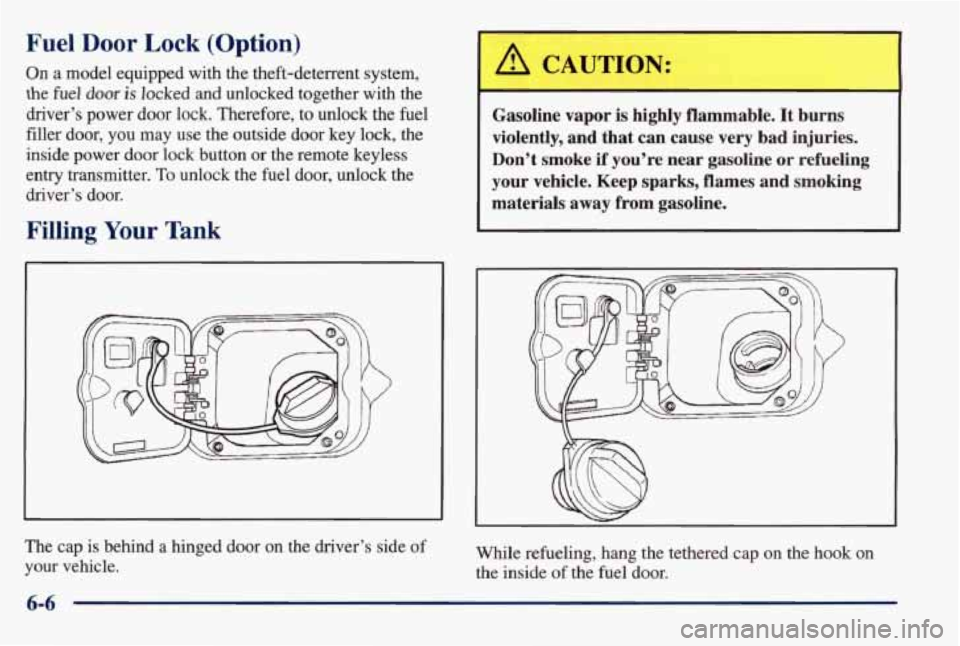
Fuel Door Lock (Option)
On a model equipped with the theft-deterrent system,
the fuel dmr is locked and unlocked together with the
driver’s power door lock. Therefore, to unlock the
fuel
filler door, you may use the outside door key lock, the
inside power door lock button
or the remote keyless
entry transmitter.
To unlock the fuel door, unlock the
driver’s door.
Filling Your Tank
L
Gasoline vapor is highly flammable. It burns
violently, and that can cause very bad injuries.
Don’t smoke if you’re near gasoline or refueling
your vehicle. Keep sparks, flames and smoking
materials away from gasoline.
The cap is behind a hinged door on the driver’s side of
your vehicle. While refueling, hang the tethered
cap on the hook on
the inside of the fuel door.
6-6
Page 259 of 395
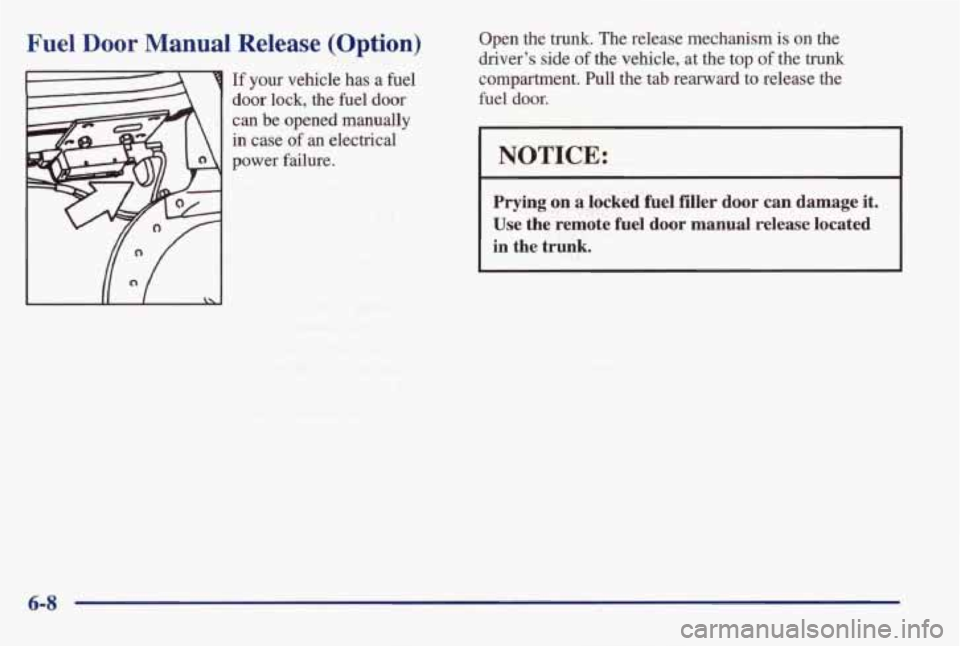
Fuel Door Manual Release (Option)
If your vehicle has a fuel
door lock, the fuel door
can be opened manually
in case
of an electrical
power failure. Open
the trunk. The release mechanism is on the
driver’s side of the vehicle, at the top of the trunk
compartment. Pull the tab rearward to release the
fuel door.
I NOTICE:
Prying on a locked fuel filler door can damage it.
Use the
remote fuel door manual release located
in the trunk.
6-8
Page 314 of 395
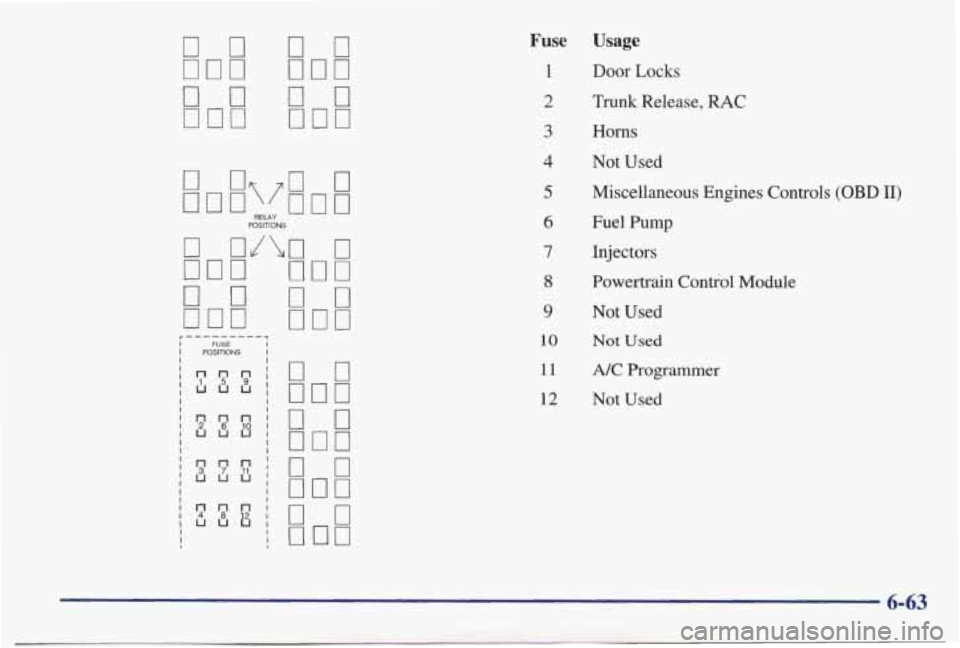
on
000
no
000
I CUM I I POSmONS I
0
no
0
00
0
on
17
00
0
on
Fuse
1
2
3
4
5
6
7
8
9
10
11
Q
Usage
Door Locks
Trunk Release, RAC
Horns
Not Used
Miscellaneous Engines Controls
(OBD II)
Fuel Pump
Injectors
Powertrain Contiol Module
Not Used
Not Used
NC Programmer
Not Used
6-63